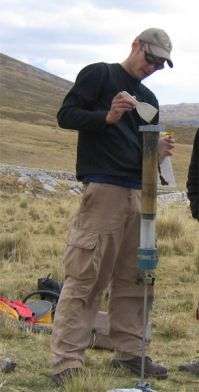Ancient Peruvian metallurgy studied

Ancient metal pollution trapped within the mud at the bottom of a lake in Peru reveals the Andean people were smelting copper as far back as 1,000 years ago.
New research of the sediments allowed researchers to discover what was smelted at what time. By retrieving a one-metre lake-sediment core, Colin Cooke, a University of Alberta Ph.D. candidate in Earth and Atmospheric Sciences, and his research team were able to measure the amount of metal pollution deposited in the lake over the past 1,000 years.
"We found the Andean people switched to smelting silver around 1450 AD, about the same time the Incas moved into the area," said Cooke.
He and his research team believe the switch to silver was made so the Andean people could pay the heavy taxes the Incas demanded in the form of silver objects.
Cooke said the research also revealed that atmospheric pollution increased tenfold when the Spanish arrived about 80 years later. He attributes that to a dramatic increase in production once the Spanish arrived.
Although it was known the Incas used silver extensively, this is the first time evidence of local smelting has been found. The research was published in the most recent issue of Environmental Science and Technology.
Cooke, who is the first author on the paper, believes there hasn't been any evidence of smelting yet because archaeologists typically deduce matters based on finding artifacts rather than look for environmental clues. As pre-colonial smelters were likely made of clay, they are poorly preserved in the archaeological record. As a result, Cooke and his team looked for the environmental legacy of smelting.
Other research team members include Dr. Mark Abbott of the University of Pittsburg, Dr. Alexander Wolfe of the U of A and Dr. John Kittleson from Pennsylvania State University.
Abbott and Wolfe had previously found evidence of pre-Inca silver smelting in the Bolivian Andes and published their findings in Science in 2003.
The research team now plans to do a bigger survey to investigate how the technology was spread throughout what was then the New World.
To help find those answers, Cooke studied Spanish documents that indicate where colonial mining took place in the Andes from 1533 onwards. Based on those documents, he identified and will study a series of sites from Ecuador to Bolivia and hopes to reconstruct the evolution of metallurgy in the New World.
Source: University of Alberta





















